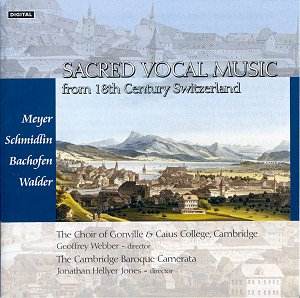This is yet another program of choral and vocal music
that leads us to wonder if there was not very good reason that most
of it lay in vaults for years unsung. The sobriety of Swiss life in
the seventeenth and eighteenth centuries caused a dearth of creative
music-making during the era. The works on this disc do little to make
a case for the music that was written.
We begin with a rather run of the mill Te deum
by Franciscus Meyer. It is a serviceable work and would suit an amateur
church choir well. It is alas, predictable and repetitive, and bereft
of much that is harmonically interesting or original. The choir of Gonville
and Caius College, Cambridge gives a decent performance here, but one
senses no real commitment to the text. Soloists are average, and tenor
Andrew Griffithsí rather swallowed tone (just that hint of a whine)
does little to blend with his fellow soloists.
Johannes Schmidlinís Gloria setting of 1758
fares better. The singing of the chorus is more energetic and focused
and the soli are better matched. The pastoral duet by Bachofen, which
follows the Gloria, is simply annoying. Cutesy little devices like the
faux-Monteverdi trillo-ette on Schäf-schäf-schäf-schäffelein
are ridiculous. Even taken tongue-in-cheek this is maddening after
the umpteenth repeat. Baritone Richard Hooper does nothing to bring
this text alive, each dreadful repetition of the refrain being more
nauseous than the last. The effect is worsened further by some deplorable
German diction. Mr. Bachofenís trio Christi Tod, des Todes Tod, is
a lovely hymn-like strophic setting. Alas, our soloists deliver each
verse with a sameness that is numbing. Soprano Julia Doyle, in an effort
to keep the vibrato out, has difficulty negotiating anything above the
stave and the result is a tightness of tone that quickly strains the
ear. The duet "Wo is Jesus meine Liebe?" fares better
as a piece of music, but is hampered yet again by inferior soloists.
Schmidlinís Magnificat is a worthy setting.
Melodic and charming it is by far and away the best work on this program.
On the whole the performance here is fine, intonation is good and soloists
play off each other in interesting fashion.
As a choirmaster I constantly debate with myself as
to when it is appropriate to use soloists from within the chorus and
when I should hire outsiders. The bulk of this disc makes a strong case
for the outsiders. Nearly every piece on the program is damaged in one
way or another by inferior soloists. Granted, this is a collegiate choir,
and a certain amount of educational consideration for student soloists
must be given. A recording, however, is forever, and it is an example
to the world of the work that goes on in any institution. I have to
wonder why Geoffrey Webber chose so many exposed solos to record, and
then foisted them upon us with clearly second-tier singing talent. One
hates to belittle the work of others, but this is a full-priced recording,
and the performances do not merit the outlay of the cash.
The Cambridge Baroque Camerata are unobtrusive accompanists
and turn in acceptable performances. Recorded sound is fine; program
notes are average at best, and not particularly informative. I wish
that I could be more charitable, but this is an average performance
of average music. Not recommended.
Kevin Sutton


![]() The Choir
of Gonville and Caius College, Cambridge, Geoffrey Webber, conductor
The Choir
of Gonville and Caius College, Cambridge, Geoffrey Webber, conductor ![]() GUILD GMCD
7248 [60:20]
GUILD GMCD
7248 [60:20]